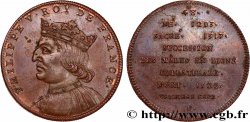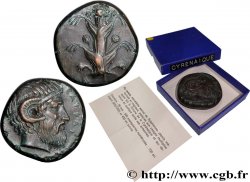Live auction - fme_956754 - III REPUBLIC Médaille, Dîner de la marmite
You must signin and be an approved bidder to bid, LOGIN TO BID. Accounts are subject to approval and the approval process takes place within 48 hours. Do not wait until the day a sale closes to register. Clicking on "BID" constitutes acceptance of the terms of use of cgb.fr private live auctions.
Bids must be placed in whole Euro amounts only. The sale will start closing at the time stated on the item description; any bids received at the site after the closing time will not be executed. Transmission times may vary and bids could be rejected if you wait until the last second. For further information check the Live auction FAQ
All winning bids are subject to a 18% buyer’s fee.
All winning bids are subject to a 18% buyer’s fee.
| Estimate : | 80 € |
| Price : | no bid |
| Maximum bid : | no bid |
| End of the sale : | 08 October 2024 15:16:29 |
Type : Médaille, Dîner de la marmite
Date: 1873/(1881)
Metal : silver plated copper
Diameter : 50,5 mm
Orientation dies : 12 h.
Engraver ROTY Louis Oscar (1846-1911)
Weight : 63,10 g.
Edge : lisse + corne CUIVRE
Puncheon : corne CUIVRE
Coments on the condition:
Médaille nettoyée, présentant de l’usure sur les reliefs. Présence de coups et rayures, notamment sur la tranche
Catalogue references :
Obverse
Obverse legend : ARTIBUS ET LIBERTATE - FLORET PATRIA // NOVEMBRE / 1873 // LIBERTE / EGALITE / FRATERNITE.
Obverse description : Tête féminine de profil à gauche, coiffée d’une couronne de feuilles d’olivier et laurier, nouées par un ruban. Victoire sur le sommet son crâne, ailé, tenant un flambeau. Signé : ROTY.
Reverse
Reverse legend : COQUIT - CIBARIA NUTRIT AMICITIAS // EUGENE CLERH / DE LA COMEDIE FRANCAISE.
Reverse description : Chaudron sur lequel est posé une branche de laurier et une louche. Nom du récipiendaire gravé dans un cartouche.
Commentary
Médaille décernée à Eugène Clerh (1838-1900), de la Comédie-Française. Ce dernier fut acteur à la Comédie Française et joua de 1864 à 1884 au théâtre national de l’Odéon, puis en 1886 au Palais du Trocadéro et en 1891 (Thermidor) et 1896 (Le Monde où l’en s’ennuie) à la Comédie-Française.
Les Dîners de la Marmite (1873-1928) est un club mondain. D’après l’ouvrage de Thierry Tessier, ces dîners réunissaient chaque mois près de 300 convives mêlant les artistes et les politiques.
Les Dîners de la Marmite (1873-1928) est un club mondain. D’après l’ouvrage de Thierry Tessier, ces dîners réunissaient chaque mois près de 300 convives mêlant les artistes et les politiques.








 Report a mistake
Report a mistake Print the page
Print the page Share my selection
Share my selection Ask a question
Ask a question Consign / sell
Consign / sell
 Full data
Full data















